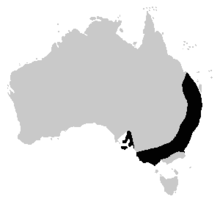Bibron's toadlet
The Bibron's toadlet or brown toadlet (Pseudophryne bibronii)[2] is a species of Australian ground-dwelling frog that, although having declined over much of its range, is widespread through most of New South Wales, Victoria, south-eastern Queensland and eastern South Australia, including Kangaroo Island.
| Bibron's toadlet | |
|---|---|
 | |
| Scientific classification | |
| Kingdom: | Animalia |
| Phylum: | Chordata |
| Class: | Amphibia |
| Order: | Anura |
| Family: | Myobatrachidae |
| Genus: | Pseudophryne |
| Species: | P. bibronii |
| Binomial name | |
| Pseudophryne bibronii Günther, 1859 | |
 | |
| Range of the Bibron's toadlet | |
Description
This species is variable and may represent more than one species. It grows to about 30mm in length and is brown, grey or black above, often with scattered red spots. It is normally strongly marbled black and white on the ventral surface, however in some areas this marbling can be faint. There is always an orange, red or yellow patch in the armpits. This patch varies from yellow to orange between sites. At the Jervis Bay region this patch is always yellow, this may be a result of hybridisation with the Dendy's toadlet (Pseudophryne dendyi) which has a strong yellow patch in the armpits. There is also a yellow/orange patch or raised bump on the back of the thigh.
Behaviour and ecology
This species inhabits areas that are likely to be inundated after rain. This can be anything from coastal swamps, creeks, temporary ponds/roadside ditches in forest, cleared land, heathland and even sub-alpine areas. When threatened, the Bibron's toadlet will often lie on its back, unresponsive, pretending to be dead. This performance had been reported to last for up to an hour.
Reproduction
The males attract the females by making a grating "ark" noise from a concealed area, in mud, under rocks or damp leaf litter. They normally call after heavy rain or when water is available, they call all year round but normally from February to June at temperatures as low as 4 °C (39 °F).
The species is polyandrous, with each female mating with several males. The female visits up to eight males, mates with each, and deposits eggs in the shallow nest he has dug.[3][4][5] The female moves on and the male tends the nest. The nest, which may contain moist leaf litter or sphagnum moss, floods during rain. The eggs hatch and the tadpoles develop in the water. If no sufficient rain happens soon after laying the eggs can remain unhatched for many weeks, with the tadpoles developing inside. The nest must stay wet so the eggs remain moist, but not too wet or they will be washed away. Female frogs that mate with more males, thus depositing eggs in more nest sites, are more likely to have some young survive.[3][4]
Sources
- Anstis, M. 2002. Tadpoles of South-eastern Australia. Reed New Holland: Sydney.
- Robinson, M. 2002. A Field Guide to Frogs of Australia. Australian Museum/Reed New Holland: Sydney.
- Frogs of Australia Network — frog call available here.
- SA EPA's Frogs of South Australia website
References
| Wikispecies has information related to Pseudophryne bibronii |
- Jean-Marc Hero; Graeme Gillespie; Frank Lemckert; Murray Littlejohn; Peter Robertson (2004). "Pseudophryne bibronii". IUCN Red List of Threatened Species. 2004: e.T18581A8482316. doi:10.2305/IUCN.UK.2004.RLTS.T18581A8482316.en.
- Frost, Darrel R. (2014). "Pseudophryne bibronii Günther, 1859". Amphibian Species of the World: an Online Reference. Version 6.0. American Museum of Natural History. Retrieved 14 April 2014.
- Byrne, P. G.; Keogh, J. S. (2009). "Extreme sequential polyandry insures against nest failure in a frog". Proceedings of the Royal Society B: Biological Sciences. 276 (1654): 115–120. doi:10.1098/rspb.2008.0794. PMC 2614246. PMID 18782745.
- Ehrenberg, R. (9 September 2008). "Female frogs play the field". ScienceNews. Retrieved 14 April 2014.
- Monash University (26 September 2008). "Australian Frog Species Chooses Not To Put Eggs In One Basket". ScienceDaily. Retrieved 14 April 2014.
